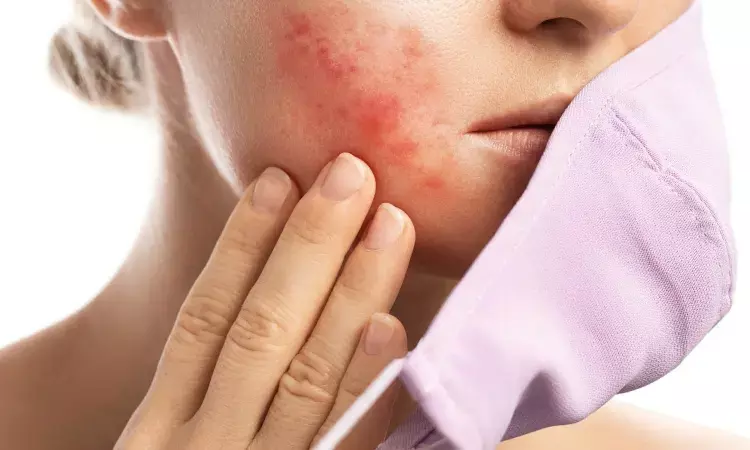- Home
- Medical news & Guidelines
- Anesthesiology
- Cardiology and CTVS
- Critical Care
- Dentistry
- Dermatology
- Diabetes and Endocrinology
- ENT
- Gastroenterology
- Medicine
- Nephrology
- Neurology
- Obstretics-Gynaecology
- Oncology
- Ophthalmology
- Orthopaedics
- Pediatrics-Neonatology
- Psychiatry
- Pulmonology
- Radiology
- Surgery
- Urology
- Laboratory Medicine
- Diet
- Nursing
- Paramedical
- Physiotherapy
- Health news
- Fact Check
- Bone Health Fact Check
- Brain Health Fact Check
- Cancer Related Fact Check
- Child Care Fact Check
- Dental and oral health fact check
- Diabetes and metabolic health fact check
- Diet and Nutrition Fact Check
- Eye and ENT Care Fact Check
- Fitness fact check
- Gut health fact check
- Heart health fact check
- Kidney health fact check
- Medical education fact check
- Men's health fact check
- Respiratory fact check
- Skin and hair care fact check
- Vaccine and Immunization fact check
- Women's health fact check
- AYUSH
- State News
- Andaman and Nicobar Islands
- Andhra Pradesh
- Arunachal Pradesh
- Assam
- Bihar
- Chandigarh
- Chattisgarh
- Dadra and Nagar Haveli
- Daman and Diu
- Delhi
- Goa
- Gujarat
- Haryana
- Himachal Pradesh
- Jammu & Kashmir
- Jharkhand
- Karnataka
- Kerala
- Ladakh
- Lakshadweep
- Madhya Pradesh
- Maharashtra
- Manipur
- Meghalaya
- Mizoram
- Nagaland
- Odisha
- Puducherry
- Punjab
- Rajasthan
- Sikkim
- Tamil Nadu
- Telangana
- Tripura
- Uttar Pradesh
- Uttrakhand
- West Bengal
- Medical Education
- Industry
Maskne prevalence and risk factors during the COVID-19 pandemic

Maskne prevalence and risk factors during the COVID- 19 pandemic
Onset of COVID-19 pandemic has instilled a habit of use of personal protective equipment (PPE) in the whole world. Mask being an important part of PPE, has become essential for healthcare workers and patients in order to avoid virus transmission. Maskne is a new coined term widely used to describe the form of mechanical acne resulting from the continuous adherence and friction of the mask to the face. Recently an article investigating the prevalence of acne related to prolonged mask wearing in patients attending the outpatient department was published in the Journal of European academy of dermatology and venereology.
A total of 384 patients (272 females and 112 males; median age 26.5) with a diagnosis of mechanical acne due to mask usage attending the dermatology clinic from February 2021 to December 2021were included in the study. Each patient was clinically evaluated and completed a questionnaire regarding the onset of acne, previous history of acne, the personal protective equipment (PPE) exposure, maskne development and the use of contributing factors.
Most patients (70.8%) were females; 64 patients (16.6%) were aged 15–20 years, 232 (60.4%) were aged 21–30 years, 71 (18.5%) were aged 31–40 years and 17 (0.5%) were > 40 years. 129 out of 384 (33.6%) patients reported a previous history of acne and 178 out of 384 (46.3%) had at least a first-degree relative suffering or had suffered of acne. All patients were Caucasians with 76.3% (293/384) reporting the onset of acne since the beginning of mask wearing and the remaining ones 23.7% (91/ 384) described a worsening of acne lesions since the mask usage. The 87.8% of patients included were type I-II Fitzpatrick scale and 12.3% were type III.
The proportion of clinical forms of acne were: 158/384 (41.1%) presented with micro-comedonal lesions, 174/384 (45.3%) presented with papulo-pustular eruptions and 13.6% (52/ 384) presented with nodulo-cystic lesions. Cheeks and chin were the most frequently involved sites. In terms of the degree of severity, 32%, 54% and 14% presented with mild, moderate and severe degree of acne, respectively.
Over half of the patients (74.5%; 286/384) reported the daily use of emollients under the mask and the majority of them worked in closed environments. A statistically significant difference in mean age (P < 0.0001), family history of acne (P < 0.0001) and maskne development [de novo acne (P < 0.01) and acne exacerbation (P < 0.0001)] was assessed between the present study population and the study by Kiely et al.2
Maskne is a facial dermatosis associated to mask use. The continuous use of mask to contain the spread of Covid-19 has caused an increase in maskne incidence. The continuous use of moisturizers can add on to the risk of maskne. The pathogenetic mechanism behind maskne and the therapeutic approach to treat and prevent it is a still mystery.
To conclude a possibility of maskne development should be kept in mind by dermatologists while advising the patients on the general measures to prevent or reduce the side effects of personal protective equipment.
Source-
- Villani A, Fabbrocini G, Annunziata MC, Potestio L. Maskne prevalence and risk factors during the COVID-19 pandemic. J Eur Acad Dermatol Venereol. 2022 Sep;36(9):e678-e680.
- Kiely LF, O'Connor C, O'Briain G, O'Briain C, Gallagher J, Bourke JF. Maskne prevalence and associated factors in Irish healthcare workers during the COVID-19 pandemic. J Eur Acad Dermatol Venereol 2022; 36:e506–e508.
MBBS
Dr Manoj Kumar Nayak has completed his M.B.B.S. from the prestigious institute Bangalore medical college and research institute, Bengaluru. He completed his M.D. Dermatology from AIIMS Rishikesh. He is actively involved in the field of dermatology with special interests in vitiligo, immunobullous disorders, psoriasis and procedural dermatology. His continued interest in academics and recent developments serves as an inspiration to work with medical dialogues.He can be contacted at editorial@medicaldialogues.in.
Dr Kamal Kant Kohli-MBBS, DTCD- a chest specialist with more than 30 years of practice and a flair for writing clinical articles, Dr Kamal Kant Kohli joined Medical Dialogues as a Chief Editor of Medical News. Besides writing articles, as an editor, he proofreads and verifies all the medical content published on Medical Dialogues including those coming from journals, studies,medical conferences,guidelines etc. Email: drkohli@medicaldialogues.in. Contact no. 011-43720751


